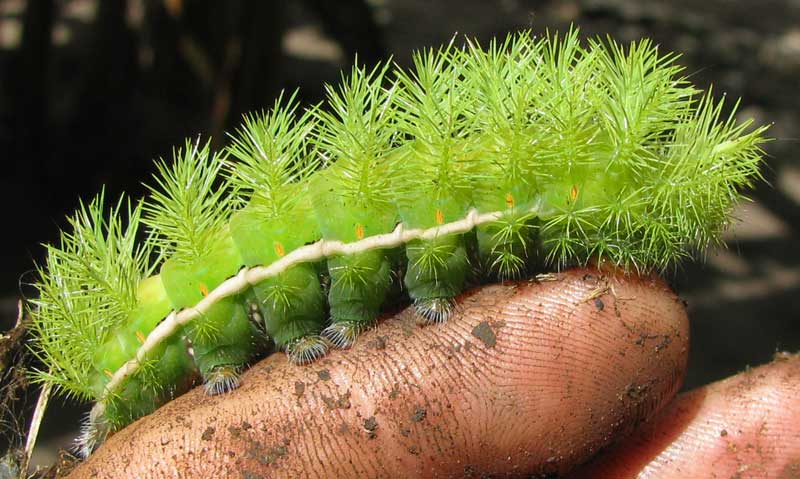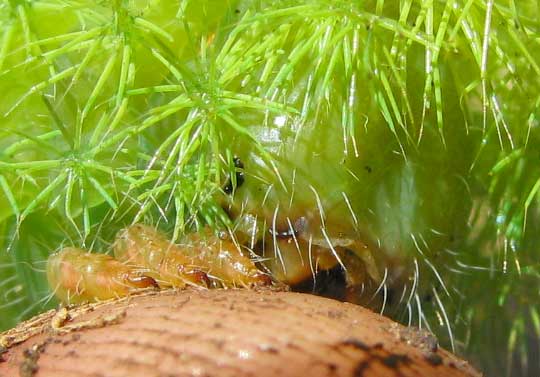Excerpts from Jim Conrad's
Naturalist Newsletter

from the November 7, 2010 Newsletter issued from Hacienda Chichen Resort beside Chichén Itzá Ruins, central Yucatán, MÉXICO; limestone bedrock, elevation ~39m (~128ft), ~N20.676°, ~W88.569°
A BIG, GREEN CATERPILLAR THAT STINGS
While shuffling around bagged palm saplings I saw a curled up green leaf fallen into a pot, grabbed the leaf, and got stung. My eyes don't focus at arm length so I'm surprised by lots of things I pick up. I figured that a scorpion had gotten me because already one had jumped from a bag (see next story). What my green, curled-up leaf turned out to be is shown above..
You can see the caterpillar's compound-eyes-dominated head and three of its six yellowish jointed legs below:

In the above picture also you can see tiny liquid globlets, presumable irritating chemicals, at the tip of many spines, plus some spine tips have been broken off, probably into my hand. Where the spines pricked my hand it burned like the dickens -- worse than fire ant stings but not as bad as those of honeybees or wasps. Hairs that sting like that, whether they're on animals or plants, are said to be "urticating" hairs.
Bea in Ontario quickly let me know that this was the larval stage of a moth of the genus Automeris. Probably the best-known member of that genus is the Io Moth, Automeris io, which occurs here. Automeris moths are big -- the Io has a wingspread of about three inches (8 cm) -- and their back wings bear large eyespots looking very much like the eyes of a watchful owl.
Neither Bea nor I could figure out with certainty which species we had so I sent the picture to Kirby Wolfe with the Natural History Museum of Los Angeles County, who has the best collection of Automeris pictures on the Internet. Kirby was afield in Costa Rica and didn't have his notes with him but he wrote back that he'd done work here and that he could remember there "... not being any difference between Automeris tridens and Automeris moloneyi larvae, either of which I believe could occur there."
From collection information found on the Internet, Automeris maloneyi seems more likely to be found here, plus pictures I find of their caterpillars look more like ours than A. tridens, so I'm parking the picture on the Internet under the name AUTOMERIS cf. MALONEYI, the "cf." meaning "confirm," used when you think you know what species it is, but you're not too sure. We used "cf." a lot when I worked in the herbarium at the Missouri Botanical Gardens in St. Louis.
All Automeris moths are nocturnal. Adult Automeris moths live so briefly that they don't even have functional mouthparts. Their whole lives are dedicated just to having sex, the female laying eggs, and then they die.